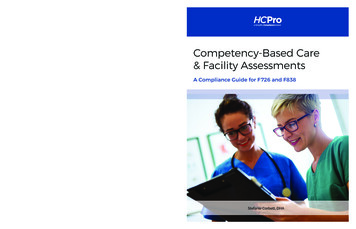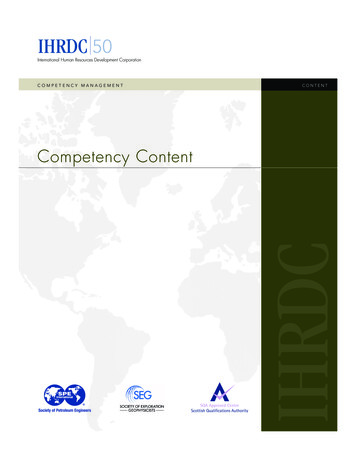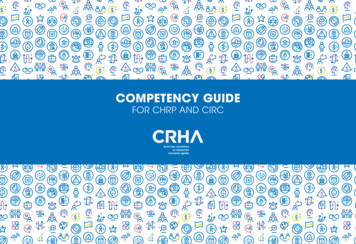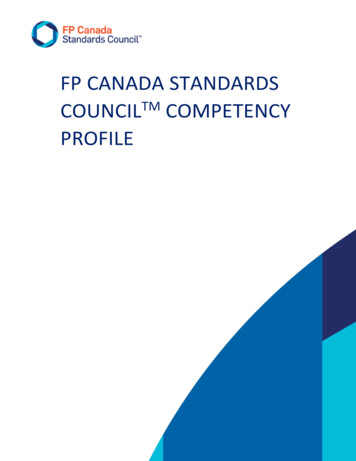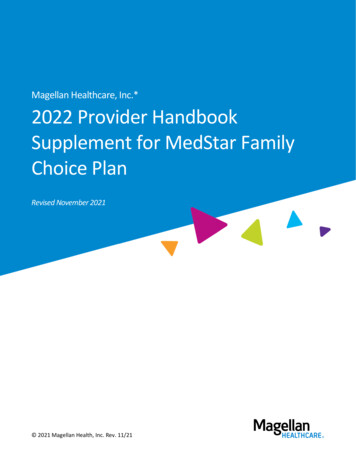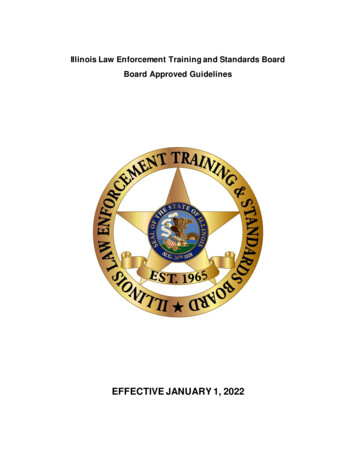
Transcription
Mather LifeWays Orange Papersare provided as a resource ontopics related to the growingfields of aging, wellness, andworkforce development. Theircontent reflects the expertise ofMather LifeWays researchers, educators,and other professionals who are leaders increating Ways to Age Well.SMDiversity & CulturalCompetency inHealth Care SettingsA Mather LifeWays Orange Paper by Dawn Lehman, PhD; Paula Fenza, MA; andLinda Hollinger-Smith, PhD, RN, FAAN
Diversity & Cultural Competencyin Health Care SettingsKnowledge of culturalcustoms enables healthcare providers to offerbetter care and help avoidmisunderstandings.Cultural Competency DefinedCultural competency is at the core of high quality, patient-centered care, and itdirectly impacts how care is delivered and received. According to the Instituteof Medicine’s report, Unequal Treatment Confronting Racial and EthnicDisparities in Healthcare, a consistent body of research indicates a lack ofculturally competent care directly contributes to poor patient outcomes, reducedpatient compliance, and increased health disparities, regardless of the quality ofservices and systems available. In addition to improving care quality and patientsatisfaction, delivering culturally competent care increases job satisfaction andcontributes to staff retention.Multiple definitions of cultural competence abound in health care literature.Culture refers to “the learned patterns of behavior and range of beliefs attributedto a specific group that are passed on through generations. It includes waysof life, norms and values, social institutions, and a shared construction ofthe physical world.” Competence is used to describe behaviors that reflectappropriate application of knowledge and attitudes. A health care professionalwho has learned cultural competence engages in assistive, supportive,facilitative, or enabling acts that are tailor-made to fit with individual, group,or institutional cultural values, beliefs, and lifeways in order to provide qualityhealth care. In other words, they demonstrate attitudes and behaviors thatenable them to effectively work with individuals with diverse backgrounds.Integrating skills in culturally competent care meets six aims for quality ofhealth care: safe, effective, patient-centered, timely, efficient, and equitable.Most important, care that is patient-centered means that all care providers truly“know” the patient and take into account cultural differences, knowledge level,and preferences.Theorist Dr. Josepha Campinha-Bacote developed the Culturally CompetentModel of Care, which identifies five constructs of cultural competence: culturalawareness (a self-reflection of one’s own biases), cultural knowledge (obtaininginformation about different cultures), cultural skill (conducting an assessmentof cultural data of the patient), cultural encounters (personal experiences withpatients of different backgrounds), and cultural desire (the process of wantingto be culturally competent). Campinha-Bacote referred to cultural competenceas a process, meaning that the health care provider should continually strive toeffectively work within the cultural context of each client.www.matherlifeways.com2
Diversity & Cultural Competencyin Health Care SettingsResearchers argue that,although the field ofcultural competence is in itspreliminary stages, there ismuch promise for continuedsuccess in the impact it canhave on health outcomesand well-being.Why a Culturally Competent Health Care Workforceis NeededFacing a rapidly aging nation, the U.S. government seeks to develop the culturalcompetence of health care providers in order to reduce health disparities. Thegrowing older adult population represents a cultural entity unto itself. Theproportion of older adults from ethnic and racial minority groups is projectedto increase exponentially by 2050, with the largest growth rates being amongHispanics, followed by Asian-Pacific Islanders, American Indians, and AfricanAmericans. In 2006, the U.S. Census Bureau indicated that 19% of the U.S.population age 65 years and older was minority. By 2050, 39% of the nation’solder adults will be represented by minority groups.In health care settings, cultural awareness, sensitivity, and competence behaviorsare necessary because even such concepts as health, illness, suffering, and caremean different things to different people. Knowledge of cultural customs enableshealth care providers to provide better care and help avoid misunderstandingsamong staff, residents/patients, and families.Culturally Competent Health Care: The BenefitsResearchers posit that culturally competent health care has many benefits: moresuccessful resident/patient education; increases in health care-seeking behavior;more appropriate testing and screening; fewer diagnostic errors; avoidance ofdrug complications; greater adherence to medical advice; and expanded choicesand access to high-quality clinicians. Researchers conclude that although thefield is in its preliminary stages, there is much promise for continued successesin the impact of cultural competence on health outcomes and well-being.Health care providers trained in cultural competency: Demonstrate greater understanding of the central role of culture in healthcare Recognize common barriers to cultural understanding among providers, staff,and residents/patients Identify characteristics of cultural competence in health care settings Interpret and respond effectively to diverse older adults’ verbal and nonverbalcommunication cues Assess and respond to differences in values, beliefs, and health behaviorsamong diverse populations and older adults Demonstrate commitment to culturally and linguistically appropriate services Work more effectively with diverse health care staff Act as leaders, mentors, and role models for other health care providersCulturally Competent Health Care in Yourwww.matherlifeways.com3
Diversity & Cultural Competencyin Health Care SettingsOrganizationThe National Center for Cultural Competence at Georgetown University statesthat cultural competence requires that organizations:Once you get pastinterpreters and otherlanguage services, you findvery little about culturalcompetence training, andwhat exists is mostly forphysicians. Have a defined set of values and principles and demonstrate behaviors,attitudes, policies, and structures that enable them to work effectively crossculturally Have the capacity to 1) value diversity; 2) conduct self-assessment; 3)manage the dynamics of difference; 4) acquire and institutionalizecultural knowledge; 5) adapt to the diversity and cultural contexts of thecommunities they serve Incorporate the above into all aspects of policymaking, administration,practice, and service delivery and systematically involve consumers, keystakeholders, and communitiesUse the following checklists to evaluate your organization’s cultural competency.By checking the items that best describe your organization, you will gaina clearer picture of your current strengths and, most important, areas ofopportunity. After the three checklists have been completed and reviewed, youwill be in a better position to determine the course of action needed to achievecultural competency in your workplace and workforce.The three checklists included are: Areas of your organization’s culture that can negatively impact quality of care(areas of opportunity) Barriers to cultural competency Recommendations for culturally competent careNumerous sources were used to develop the checklists (see References). Primarysources were Spector and Christensen Community Consulting.Checklist: Diversity & Cultural Competency in HealthCare SettingsAspects of the health care provider’s culture that can negatively impact quality of careBeliefsStaff holds different beliefs about the nature of health and illnessStaff believes in the omnipotence of Western medicineStaff believes in the omnipotence of technologyStaff stereotypes culture groupsStaff’s misconceptions about the nature and quality of residents’/patients’health care practiceStaff’s general interpretation of the cause of illnessStaff assumes health professional knows bestwww.matherlifeways.com4
Diversity & Cultural Competencyin Health Care SettingsAttitudesThere is a lack of consensuson which racial ethnicgroups should be studied bynurses, a contributing factorto inadequate culturalcompetence education.Staff expects promptnessStaff expects complianceStaff takes paternal approachStaff disrespects non-traditional healing practicesStaff does not consider residents’/patients’ conflict regarding familiar beliefsystems and current practicesStaff does not keep an open mindBehaviorsStaff does not adjust approach to coincide with the needs of the resident/patientStaff relies on technology/procedures to identify problemStaff limits time with residents/patientsStaff uses jargonStaff limits communications with familyStaff tries to force use of Western medicineStaff does not agree on type and quality of careStaff miscommunicatesRitualsStaff does not consider residents’/patients’ attitudes and beliefs regarding thephysical examinationStaff does not greet residents/patients in a culturally appropriate wayChecklist: Diversity & Cultural Competency in Health Care SettingsBarriers to Cultural Competency in OrganizationsResidentsMany residents/patients lose their capacity to communicate in theirsecondary language and revert to their first language.There is a move in immigrant communities toward professionalized care forfrail seniors.Seniors who have been living with their adult children often expect the samelevel of individualized and personalized service when they enter a longterm care home. Their high expectations frequently cannot be met bothbecause of regulatory requirements (e.g., food service regulations) andavailable resources/funding.Residents/patients who need assistance in completing their washing ritualbefore prayers may find that staff is not available to help them.Residents/patients from different cultures are not used to the food they areserved and find it difficult to adapt to a change in diet later in life.The availability of physical care is linked to spiritual support and care. Forwww.matherlifeways.com5
Diversity & Cultural Competencyin Health Care Settingsexample, a resident/patient may not be able to pray if s/he has been incontinentand his/her continent briefs are wet or soiled and/or if s/he has been unable towash.OrganizationComplete culturalawareness, sensitivity,and competence behaviorsrelated to health care arenecessary because evengeneral ideas of health,illness, suffering, and caremean different things todifferent groups of olderadult patients.Increasing levels of care put pressure on available staff and resources.The diversity of linguistic, cultural, and spiritual groups makes it difficult forany single health care setting to recruit staff that reflects that diversity.Operational logistics make it difficult to provide linguistically, culturally, andspiritually appropriate care.There is a need to engage families and communities in a mutual learningprocess that informs program development and supports the organization’scapacity to tailor services to residents’/patients’ needs.Stereotyping and misdiagnosis may lead to misinterpretation of behaviors ashostility or agitation.If clinicians do not understand the appropriate linguistic descriptors, theymay fail to elicit the correct information about symptoms or maymisconstrue them.Cultural differences between health care workers themselves and withinorganizations can cause potential conflict in the workplace and can createbarriers to providing quality care.If information is not available to residents and their families because of thelanguage barrier, effective communication is impossible.It is difficult to accommodate small groups speaking different languages thatmay also need translation.Language barriers and ethno-specific issues cannot be addressed as long asthe sector depends on personal support workers who have minimaltraining and possibly limitedEnglish language skills.Poor communication can lead to a lack of respect for persons whose culturalvalues are different from one’s own.The extent of ethno-cultural diversity in some organizations complicates theprocess of developing programs and services suitable for everyone’s specificneeds.Many long-term organizations assign residents to units within the homeaccording to their health and social needs and/or type of accommodation(private, semi-private); thus, it may not be possible to place every residentfrom specific ethno-culturalcommunities in the same unit or even on the same floor.Large ethnic, linguistic, and spiritual communities are not monolithic, whichcomplicates programming and service delivery.Staff may see residents/patients from the perspective of providing health care(the “medical model”), rather than from the perspective of providingholistic care within a comfortable home environment.Food service regulations define how and when meals are served. For somewww.matherlifeways.com6
Diversity & Cultural Competencyin Health Care SettingsMany Black Americansview receiving health careas a degrading, demeaning,or humiliating experience,and have a feeling ofpowerlessness and alienationin the system.groups, the way in which food is served and meal times are not culturallysensitive or religiously appropriate.The pressure to fill beds in long-term care organizations creates somedifficulty in establishing and maintaining specific units for ethno-culturaland religious groups.It is difficult to compare ethnic foods and spices with dietary guidelines.Compliance requirements prohibit flexibility and adaptability in providingdiets in accordance with dietary laws (e.g., kosher foods).FamilyFamilies may not know the right questions to ask regarding services offeredwithin the organization, limits on what the organization can do for theresidents/patients, resources that are available, or how to engage thoseresources.Families do not or cannot—for cultural or linguistic reasons—discuss theirexpectations with the organization.Families may find it hard to visit and participate in programs with residents,especially if they do not have access to transportation.Volunteerism is not part of the value system in some ethno-culturalcommunities, and adult children may not be interested in participating insocial and cultural activities with residents.CommunityWithout the encouragement and support of community partners,organizations face challenges in meeting the needs of residents fromrecently arrived or smaller ethno-cultural or religious groups.Regulatory requirements may restrict the degree to which organizations canadapt their current practices to accommodate ethnic groups with differentperspectives and backgrounds.Recommendations: Cultural Competency in SeniorLiving CommunitiesCultural AwarenessDecrease ethnocentrism by being aware of one’s own cultural values andbiases.Be aware of the various myths and stereotypes related to older people.Recognize that ageism, like racism, affects all aspects of society, includinghealth professions, and can adversely affect optimal care of residents.Understand that there may be racist attitudes and beliefs among families andresidents.Learn how to communicate more effectively to decrease racist attitudes.1Identify ethnic groups, not just race.www.matherlifeways.com7
Diversity & Cultural Competencyin Health Care SettingsMany Chinese find someaspects of Western medicine(e.g., diagnostic tests)distasteful. Some are upsetby the drawing of blood.Identify immigration level (i.e., first generation or later).Assess English competency.Identify help-seeking behavior patterns through health education and opencommunication.Understand mistrust of senior living communities and other health careorganizations by some minority families.Be aware of cultural differences in attitudes toward illness and acceptance ofhelp.Staff should let residents know that they understand their views towardillness and medical treatment.Staff can encourage participation of other staff members of the same race/ethnicity/religion or a “local healer” (including clergy).Involve family or key supports from the resident’s social network.Ask community-based key informants who are knowledgeable about theethnic minorities being served to act as “culture brokers.” This person,who ideally is also familiar with the operating and regulatory environmentdefining long-term care homes, could facilitate the design of culturallyappropriate programs and services.Employ bilingual staff, rather than a family member or paid translator, whomay be more comfortable for the resident because they have moreextended contact with them.Use culturally specific phrasing and patterns of expression to gain residentcompliance.Be aware of cultural variants in the expression of psychological distress.Encourage staff to see themselves working in each resident’s home rather thanseeing them as people who happen to live in the staff’s work environment.Involve everyone in the organization—staff, residents, family members,board members, community partners, and volunteers—in assessing theirperceptions of cultural problems and conflicts, and plan how they shouldbe fixed. This opens up issues for communication that may have beensuppressed.LeadershipThe Department of Health and Human Services Culturally and LinguisticallyAppropriate Services (CLAS) standards recommend the recruitment,retention, and promotion of a diverse staff and leadership at all levels ofthe organization.Leadership at the top, as opposed to good practices by individual staffmembers who may leave the organization, is critical to creating aconsistent, sustainable environment characterized by good practices.Making a business case for cultural competency is a critical element forchange.Share knowledge and lessons learned with other organizations.www.matherlifeways.com8
Diversity & Cultural Competencyin Health Care SettingsWorkplace PracticesSome American Indianfamily members andcommunities minimizememory loss and dementiaand may not consent totreatment unless physicalfunction is impaired.Show compassion for the families of the residents and the difficulties theyface.Observe religious holidays and provide a place of worship that is respectfulof residents’ spiritual beliefs. Refrain from installing permanent symbolsthat may be offensive to other faiths. Consider moveable adornments forworship.Accommodate individual needs if possible (e.g., setting up a small Hindushrine in the resident’s room).Offer culturally appropriate meal choices. Learn about these choices fromthe cultural community.Allow cultural décor and signage to personalize rooms.If the resident agrees, encourage groupings with others of similar cultural,linguistic, or religious backgrounds (e.g., at meals).Provide television and radio programming that is culturally and linguisticallyappropriate.Using a communication board (e.g., pictures plus words in the resident’slanguage) to facilitate staff-resident communication.Post activities and programs in different languages.Offer greater flexibility in family and caregiver visiting hours.Offer flexibility in scheduling dressing, bathing, and meal times.Help staff develop flexibility in communicating with each other acrosscultural or language divides. Help them apply these skills in their workwith residents who are different from them.Wherever possible, arrange to have someone who speaks the language and/oris familiar with or part of the same culture to greet the new resident andease the transition. The “greeter” could be another resident, a staffmember, or a volunteer.Explore the feasibility of English as a Second Language lessons for residentswho are able to participate.Translate brochures, signage, and key documents/information materials(consent forms, handbooks) into other languages. Have individuals fromthe group you are trying to reach review any materials you plan to use foroutreach.Avoid literal translations of existing material as they lose their meaning whensyntax and vocabulary are not within cultural contexts.Convene a family support group for those whose family members areresidents of long-term care communities.Provide internships for diverse health profession students to gain insight fromtheir perspectives.Measure and track cultural competence as part of the effort to deliver high-quality care.In addition to cultural assessment tools, organizations can conduct focusgroups with or administer satisfaction surveys to family members ofresidents.www.matherlifeways.com9
Diversity & Cultural Competencyin Health Care SettingsHave meaningful processes for community representation and feedback,including focus groups, advisory committees, and/or board representation.Employ a patient advocate from the ethnic community who can serve as thebridge inbringing health care services to the residents.Training & EducationOffer cultural sensitivity training on a regular basis to address issuesassociated with literacy, language barriers, family support, the need forrespect, traditions, and alternative health and illness remedies.Provide “Lunch ‘n’ Learn” opportunities for staff. Invite speakers from diversecommunities to talk about their ethnic group, or invite representativesfrom organizations to talk about their best practices working with adiverse group of people.Provide basic language classes for staff.Encourage individual staff members to learn a few phrases in severallanguages spoken by residents.Recruit staff who are open-minded and view training as a learningopportunity.Exhibit information on cultural competence and provide opportunities forstaff to attend professional meetings and conferences.Obtain resources such as poetry, books, religious texts, and music from anethnic community.Administer a cultural competency assessment.Community OutreachLearn who are the most effective resource people in ethnic communities (e.g.,local neighborhood government advisory group representatives, churchcommittee chairs, local business owners, funeral planners, teachers) andenlist their support for your program.Anticipate the need for partnerships so that when residents arrive, theorganization is prepared to provide relevant services.Reach out to ethno-cultural and religious communities to engage trainers(e.g., spiritual leaders) who understand the cultural background ofresidents and train staff in the nuances of working with residents todemonstrate respect.Seek information from experts (e.g., professors, graduate students, culturalorganizations/associations, and other organizations) with a history ofserving diverse ethnic groups.Recruit bilingual and minority volunteers from churches and establishedvolunteer organizations such as AmeriCorps and Retired SeniorsVolunteer Program (RSVP).Encourage families to bring friends and community members as friendlyvisitors as often as possible.www.matherlifeways.com10
Diversity & Cultural Competencyin Health Care SettingsPromoting Safety & Quality of CareCLAS, Office of Minority Health: CLAS is a tool that promotes cultural and linguistic competence. CLAS standards are primarily directed at health care organizations; however,individuals also are encouraged to use the standards to make their practicesmore culturally and linguistically accessible. The principles and activities of culturally and linguistically appropriateservices are integrated throughout an organization and undertaken inpartnership with the community served.JCAHO now The Joint Commission (a nonprofit formed in 1951): Mission: to improve the safety and quality of care provided to the publicthrough the provision of health care accreditation and related services thatsupport performance improvement in health care organizations. Policy: views the delivery of services in a culturally and linguisticallyappropriate manner as an important health care safety and quality issue. For general information on standards related to cultural competency, contacthlc-info@jointcommission.org.Dawn Lehman, PhD, Mather LifeWays’ director of education; Paula Fenza, MA,grants manager; and Linda Hollinger-Smith, PhD, RN, FAAN, vice president, havedeveloped programs, presented papers, and conducted workshops on cultural competencyfor health care providers serving older adults. Ms. Lehman can be reached at dlehman@matherlifeways.com.Mather LifeWays is a unique nonprofit organization that enhances the lives of olderadults by creating Ways to Age Well.SM For more information about our senior livingresidences, community initiatives, or award-winning research, please visit www.matherlifeways.com or call (847) 492.7500.04009-001nwww.matherlifeways.com11
Diversity & Cultural Competencyin Health Care SettingsReferencesAdams, V.H., III, & Jackson, J.S. (2000). The contribution of hope to thequality of life among aging African Americans: 1980-1992. International Journalof Aging and Human Development, 50(4), 279-295.It is important that culturalcompetence is viewedas nursing competence,meaning that nurses havethe capacity to be equallytherapeutic with olderadult patients from anysocial context or culturalbackground.Adler, R. (2004). Introduction to cross-cultural health care for older adults. InR. Adler and H. Kamel (Eds.) Doorway thoughts: Cross-cultural health care forolder adults (pp. 2-15). Boston: Jones and Bartlett Publishers.Administration on Aging. (2000). Achieving cultural competence: Aguidebook for providers of services to older Americans and their families. U.S.Department of Health and Human services. ency for Health Care Policy and Research. (1999). Understanding andeliminating minority health disparities (RFA: HS-00-003). Rockville, MD:Agency for Health Care Policy and Research.Agency for Healthcare Research and Quality. (2004). National healthcaredisparities report. Rockville, MD: Agency for Healthcare Research and Quality.Ahmed, S.M., & Lemkau, J.P. (2000). Cultural Issues in the Primary Care ofSouth Asians. Journal of Immigrant Health, 2(2), 89-96.Alecxih, L. (2001). The impact of sociodemographic change on the future oflong-term care. Generations, 1, 7-16.Aleman, S. (1999). Therapeutic interventions with ethnic elders: Health andsocial issues. New York: Haworth Press.American Academy of Nursing. (1992, November/December). Culturallycompetent health care. Nursing Outlook, 40(6), 277-283.American Geriatrics Society. (2004). Doorway thoughts: Cross-cultural care forolder adults. Subury, MA: Jones and Bartlett.Anderson, L.M., Scrimshaw, S.C., Fullilove, M.T., Fielding, J.E., & Normand,J. (2003). Culturally competent healthcare systems. A systematic review.American Journal of Preventative Medicine, 24(3 Suppl), 68-79.Andresen, J. (2001). Cultural competence and health care: Japanese, Korean,and Indian patients in the United States. Journal of Cultural Diversity, 8(4),109-21.Andrews, M.M. Chapter on cultural assessment. In C. Jarvis. (2002). Healthassessment. Philadelphia: W.B. Saunders Company.Andrews, M.M., & Applegate-Krouse, S. (2005). Health and well-being ofurban Indian elders. Journal of Native American Research, 29(1), 65-77.Andrews, M.M., & Boyle, J.S. (2002). Transnational concepts in nursing care.Journal of Transcultural Nursing, 13(3), 178-180.Autotte, P. A. (1995, September). Folk medicine. Archives of Pediatrics &www.matherlifeways.com12
Diversity & Cultural Competencyin Health Care SettingsAdolescent Medicine, 149(9), 949-950.Axtell, R. E. (1991). Gestures: The do’s and taboos of body language around theworld. New York: Wiley.Barr, D.A., & Wanat, S.F. (March 2005). Listening to patients: cultural andlinguistic barriers to health care access. Family Medicine., 37(3), 199-204.It is important that culturalcompetence is viewedas nursing competence,meaning that nurses havethe capacity to be equallytherapeutic with olderadult patients from anysocial context or culturalbackground.Baer, R. D., Clark, L., et al. (1998). Folk illnesses. In Handbook of immigranthealth (pp. 183-202). New York: Plenum Press.Barresi, C. M., & Stull, D. E. (Eds.). (1993). Ethnic elderly and long-term care.New York: Springer.Bartol, G. M., & Richardson, L. (1998). Using literature to create culturalcompetence. Image: Journal of Nursing Scholarship, 30(1), 75-79.Bates, M. S. (1996). Biocultural dimensions of chronic pain: Implications fortreatment of multi-ethnic populations. Albany, NY: State University of NewYork Press.Berkanovic, E., & Telesky, H. (1985). Mexican-American, Black-American, andWhite-American differences in reporting illness, disability, and physician visitsfor illnesses. Social Science & Medicine (20), 567-577.Betancourt, J.R., Green, A.R., & Carrillo, J.E. (October 2002). Culturalcompetence in health care: Emerging frameworks and practical approaches. NewYork, NY: The Commonwealth Fund.Blackhall, L. J., Michel, V., Murphy, S. T., et al. (1998). A discourse ofrelationships in bioethics: Patient autonomy and end-of-life decision makingamong elderly Korean Americans. Medical Anthropology Quarterly, 12, 403423.Boi, S. (2000, September-October). Nurses experiences in caring for patientsfrom different cultural backgrounds.including commentary. NT Research,5(5), 382-390.Bonder, B., Martin, L., & Miracle, A. (2001). Achieving cultural competence:The challenge for clients and healthcare workers in a multicultural society.Generations, 25(1), 35-43.Brach, C., & Fraser, I. (2000). Can cultural competency reduce racial and ethnichealth disparities? A review and conceptual model. Medical Care Research andReview, 57, 181-217.Brach, C., & Fraser, I. (2002). Reducing disparities through culturallycompetent health care: An analysis of the business case. Quality Management inHealth Care, 10(4), 15-28.Brangman, S.A. (1995, February). African-American elders: Implications forhealth care providers. Clinics of Geriatric Medicine, 11(1
A Mather LifeWays Orange Paper by Dawn Lehman, PhD; Paula Fenza, MA; and Linda Hollinger-Smith, PhD, RN, FAAN Mather LifeWays Orange Papers are provided as a resource on topics related to the growing fields of aging, wellness, and workforce development. Their content reflects the expertise of Mather LifeWays researchers, educators,


